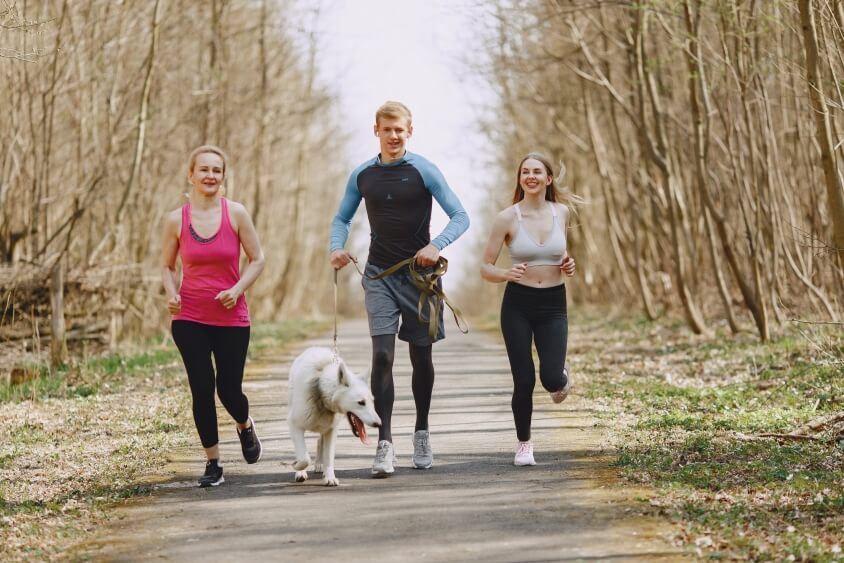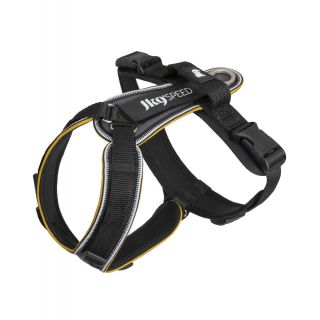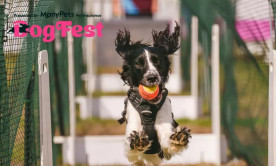Going for a run with your dog has many benefits. It provides your dog with a high level of exercise, mixes up their routine, provides added motivation for yourself, and is also a great opportunity to bond.
However, you shouldn’t just simply slip on your running shoes and grab the dog when you’re going out the door. It is important to have a basic understanding of how to jog with your dog safely and responsibly.
Not All Dogs Are Suitable For Running
Some breeds love running, for example jack russells, vizslas, and golden retrievers. But your dog’s overall health and breed should be taken into account before any form of exercise. Certain breeds have genetic issues, joint problems, and are not developed for running comfortably.
Short-nosed and flat-faced breeds like pugs and bulldogs will struggle with breathing in enough oxygen through their narrower airways while undertaking prolonged high activity exercise.
Short-legged breeds like dachshunds and corgis will find it very difficult if not impossible to keep up with you, even at a slow running pace.
More senior dogs could also have a hard time due to aging joints and their general stamina.
Some owners mistakenly presume that dogs of larger breeds are more resilient and have greater stamina, but many can suffer from genetic issues like Exercise Induced Collapse (EIC) or hip and elbow dysplasia. While this shouldn’t put you off introducing more active exercising routines other than walking, you should ask your veterinarian about potential risks before your first jogging session.
Your Dog Should Know Basic Commands
If you struggle to control your dog when out for regular walks then you then you shouldn’t go for runs just yet. It is important for your safety, your dog’s safety, and the safety of others that you can bring your dog under control quickly.
During any active exercise dogs can become over excitable; this includes jogging. Being able to get your dog to heel and stop on command will help keep everyone safe. Another important command is ‘leave it’ to avoid your dog becoming distracted by their surroundings. Your dog should also be comfortable and well behaved around other dogs and people. Not only is basic discipline important for safety but will also result in a better running experience.
Plot Your Route
Many joggers have set routes they like to take, while others like to keep their running path flexible depending on how they feel once they get going.
When jogging with a dog it’s recommend that you know the route is suitable. Avoiding busy junctions is an obvious one, but also be aware if the route takes you onto road at any point. This is more common in rural areas where routes are sometimes connected only by roads. Running even with disciplined dogs along a road when a car passes can spook dogs and make drivers uneasy, so this is are best avoided.
Consider first walking the dog along you planned route so they are used to all the smells and sights. Even when dogs know a route well they will sniff and pee to mark areas regularly. At the start of your run allow them to mark territory and sniff regularly then ease them off the further you get into your run.
Using the Right Equipment
Elastic Leashes
When out running your dog’s lead will need to be long enough to provide enough slack for comfort and safety, but not too long where it’s a trip or tangle hazard. This why stretchable material leads are recommended. Elasticised ones like our Premium Dog Elastic Lead means the leash won’t get under your feet but provide enough slack. These leashes are also much better at absorbing sharp tugs from your dog safely.
Going hands-free
Using a leash belt to free up your hands will make the jogging experience easier and more enjoyable for you and your dog. It will allow you to run more naturally, reduce leash pulling, and keep your dog at a safe distance. Our JK9® Speed Dog Running Belt has front padding for extra comfort and is fully adjustable to ensure that stays in a comfortable position.
Weather protection
If you and your furry running partner aren’t put off by the cold or rain then consider an all weather vest for your dog. The IDC® Dog Vest is made from waterproof neoprene material which also provides wind protection and thermal insulation to help keep your dog warm and dry.
Staying Visible
Although it’s not recommended to go jogging with a dog near busy roads, being seen at night is still important in quieter areas. It’s not only good practice to wear hi-vis gear when running after dark by yourself, but even when taking your dog for its regular walk.
Kitting your dog out with safety lights and reflective accessories like leashes, harnesses, or vests is an effective way of staying visible. We stock a range of official JULIUS-K9® high visibility dog accessories so you can be sure to find something suitable.
Clean up
Any responsible owner knows to always carry doggy bags with them whenever they’re out - this is no different when jogging. You’re route might mean you won’t pass a bin any time soon so taking a portable dog poop dispenser with you will come in handy.
Hydration
Don’t forget that your four-legged running partner will need a drink as well. Collapsible dog bowls make it easy to keep your dog hydrated when you take a breather.
Protection From Ticks & Parasites
Tick season in the UK starts in September and so if your running route takes you off into a more rural trail then you and your dog may be at risk of picking up ticks and other parasites. Making sure your pet is up to date with tick medication is always important but you can also use parasite repellents like spot-on treatments, flea collars, or even ultrasonic attachments to deter pests.










